AngularJS Performance
02 Dec 2014
艰难历程
系统里面使用AngularJS 做了一个类似Trello 的看板页面, 用来显示任务列表. 但是发现, 打开任务详情几次之后, 就非常卡了.
最初以为是看板里面元素太多, 造成ng-repeat 性能下降引起的问题. 于是升级了一下Angular 的版本到1.3, 并使用其中的
bind once的特性来绑定页面上那些不会再变化的内容.尝试使用Developer Tool 里面的Profile, 结果不会用. 看不出对象是不是释放掉了.
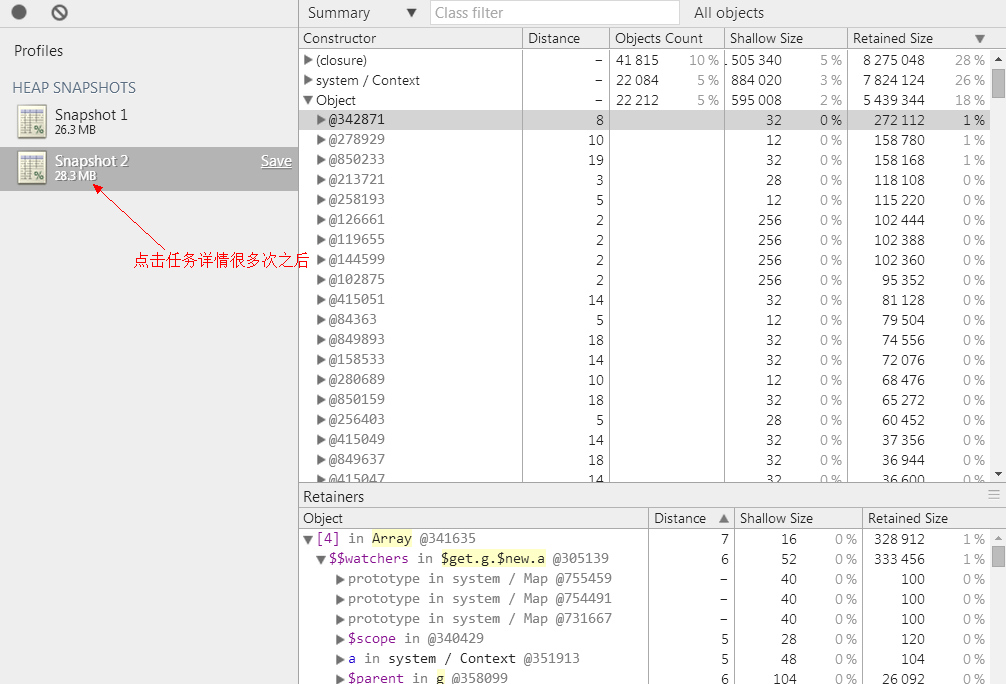
图: 对象太多, 完全找不到了
使用了个笨办法, 在任务的对象放一个很大的数组.
function alloc() { var largeObject = []; for (var i = 0; i < 1000000; i++) { largeObject.push(10000000 * i + "?"); } return largeObject; } $scope.task.largeArray = alloc();这下效果明显了. 然后就发现, 任务详情的窗口关闭之后, task 对象还一直存在.
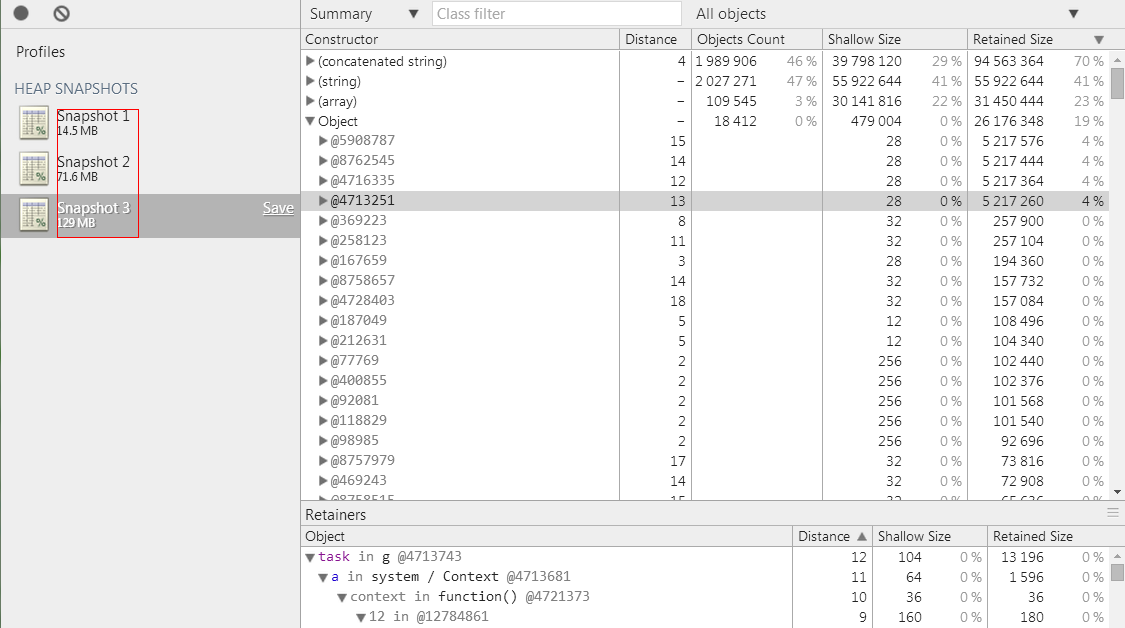
图: Task 对象不能被释放
一开始还以为是Profile 的时候没有GC 的关系, 但是后来看文档发现, 进行Profile 会自动先进行GC.
是什么引起task 对象不能释放呢? 首先怀疑是
$modal. 会不会是这里面有什么bug?于是写了个简单的页面来进行测试:
$scope.modal = function modal() { $modal.open({ templateUrl: 'angular/views/modal.html', controller: function ModalCtrl($scope, $modalInstance) { $scope.modalLargeObject = alloc(); $scope.close = function close() { $modalInstance.close($scope.modalLargeObject); }; } }).result.then(function() { console.info('close'); }, function() { console.info('dismiss'); }); };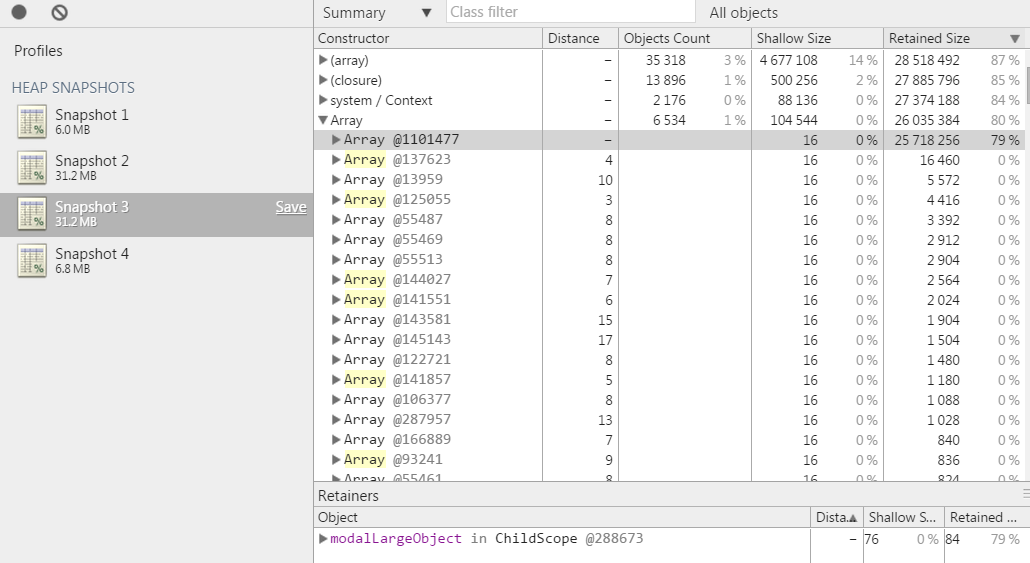
图: 多次弹出Modal 的Profile
对Profile 界面上的几个列不太明白是干啥的, 找了一下:
Shallow sizeThis is the size of memory that is held by the object itself.
对象本身占用内存的大小,不包含对其他对象的引用.
Retained sizeThis is the size of memory that is freed once the object itself is deleted along with its dependent objects that were made unreachable from GC roots.
该对象被 GC 之后所能回收到内存的总和.
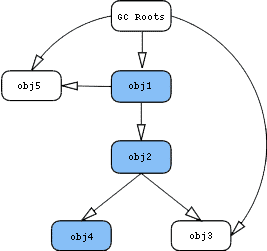
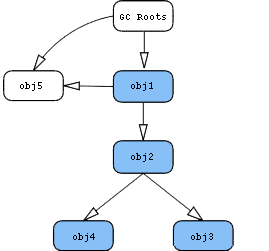
从 obj1 入手,图中蓝色节点代表仅仅只有通过 obj1 才能直接或间接访问的对象。因为可以通过 GC Roots 访问,所以左图的 obj3 不是蓝色节点;而在右图却是蓝色,因为它已经被包含在 retained 集合内。
所以对于左图, obj1 的 retained size 是 obj1, obj2, obj4 的 shallow size 总和;右图的 retained size 是 obj1, obj2, obj3, obj4 的 shallow size 总和。 obj2 的 retained size 可以通过相同的方式计算。
那到底是什么原因, 使得Task 不能被释放呢? 该如何定位问题?
我还是使用最笨的办法, 先把任务详情的html 和Controller 里面的内容都注释掉, 然后一点点放开, 看到底是哪一部分使得内存无法释放.
经过好长好长好长...一段时间的折腾, 终于发现问题点:
// 好多个directive 都有这样的代码 element.parents().click(function(){ $scope.closePanel(); $scope.$apply(); });这里面的问题是什么?
给element 的所有parent (包括document.body) 都绑定了click 事件. 那么Modal 关闭之后, 这个事件绑定还存在, 这样的话, 这个事件引用到的资源就无法释放了.
这里还涉及到闭包.
Closures / 闭包Closures are functions that refer to independent (free) variables.
In other words, the function defined in the closure 'remembers' the environment in which it was created.
function startAt(x) { function incrementBy(y) { return x + y; } return incrementBy; } var closure1 = startAt(1); var closure2 = startAt(5);既然发现问题, 于是进行调整:
function closeHandler = function(){ $scope.closePanel(); $scope.$apply(); }; var parents = element.parents(); parents.on("click", closeHandler); $scope.$on("$destroy", function() { // 当$scope 销毁的时候, 解除这些事件绑定 parents.off("click", closeHandler); })把这样的都修改完, 然后进行测试, 内存基本上比较平稳了. Profile 也不会出现大量无法释放的Task 对象. 观察Chrome 的Task Manager 里面的JavaScript Memory 变化, 内存能够得到释放(上涨了一段之后, 会进行回收, 释放后的内存使用量和开始时差不多).
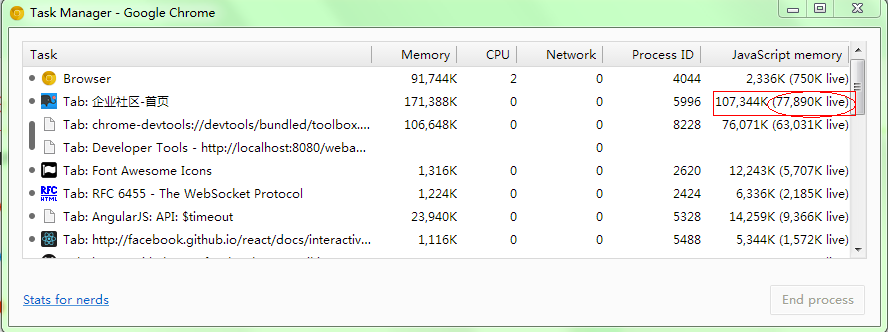
图: Task Manager 的JavaScript Memory
另一个性能问题
任务列表里面, 点击任务名称, 要等很长时间(1 分多钟)才会弹出任务详情.
这个感觉跟内存没有关系了, 于是尝试使用Developer Tool 里面的Timeline 来看这一段时间发生了什么事.
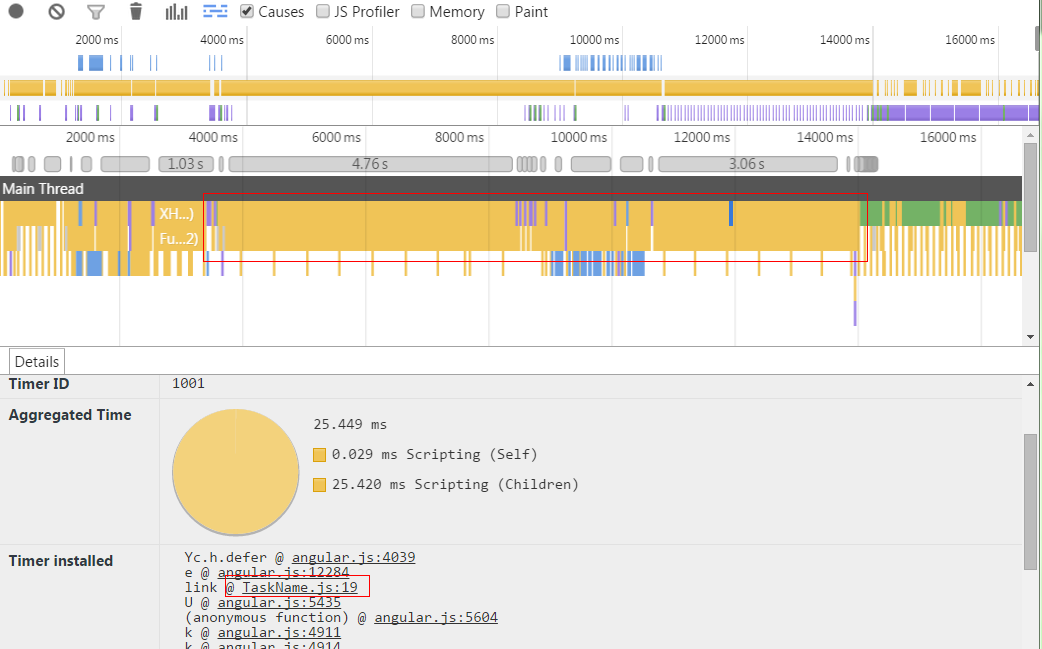
图: TaskName 花了很多时间执行
看下代码:
$timeout(function() {
$scope.isMultiRow = elem.height() > LINE_HEIGHT;
Tasks.length = 0;
}, 0);
看来是因为任务数量多的时候这里触发太多次消息循环了($timeout 默认情况下会触发AngularJS 的消息循环).
这个代码和一个界面设计有关, 在和需求商量之后, 把这个$timeout 处理去掉了.
如果$timeout 里面的代码不需要触发消息循环, 那么应该给$timeout 调用加上第三个参数, 并传递false 过去.
$timeout(function() {
// code
}, 0, false);
几个小技巧
在Developer Tool 的console 面板里面, 可以用$0, $1, ..., $4, 来引用在element 面板最近点击到的元素.
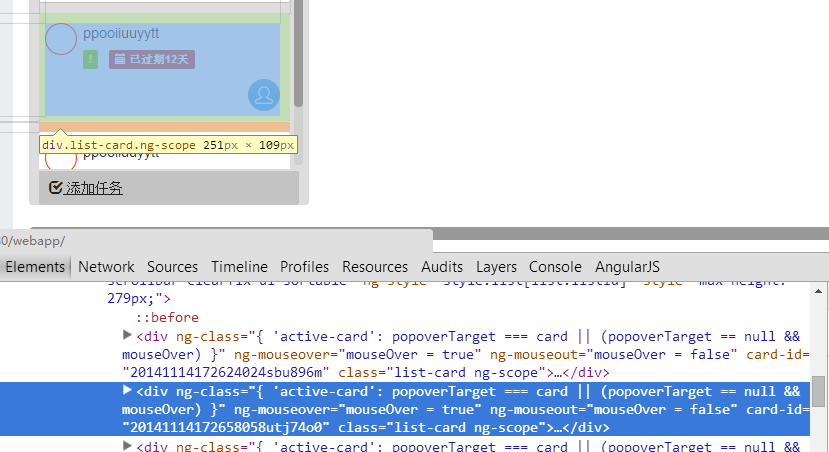
图: 在element 上选取元素

图: 在console 上使用$0 获取dom
console.time
console.time("Array initialize"); var array= new Array(1000000); for (var i = array.length - 1; i >= 0; i--) { array[i] = new Object(); }; console.timeEnd("Array initialize");
图: console.time 输出